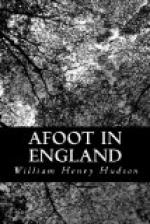What was it in these human mites, these fantastic Brownies, which, in that crowd of Rowenas and their children, made them seem like beings not only of another race, but of another species? How came they alone to be distinguished among so many by that irresponsible gaiety, as of the most volatile of wild creatures, that quickness of sense and mind and sympathy, that variety and grace and swiftness—all these brilliant exotic qualities harmoniously housed in their small beautiful elastic and vigorous frames? It was their genius, their character—something derived from their race. But what race? Looking at their mother watching her little ones at their frolics with dark shining eyes—the small oval-faced brown-skinned woman with blackest hair—I could but say that she was an Iberian, pure and simple, and that her children were like her. In Southern Europe that type abounds; it is also to be met with throughout Britain, perhaps most common in the southern counties, and it is not uncommon in East Anglia. Indeed, I think it is in Norfolk where we may best see the two most marked sub-types in which it is divided—the two extremes. The small stature, narrow head, dark skin, black hair and eyes are common to both, and in both these physical characters are correlated with certain mental traits, as, for instance, a peculiar vivacity and warmth of disposition; but they are high and low. In the latter sub-division the skin is coarse in texture, brown or old parchment in colour, with little red in it; the black hair is also coarse, the forehead small, the nose projecting, and the facial angle indicative of a more primitive race. One might imagine that these people had been interred, along with specimens of rude pottery and bone and flint implements, a long time back, about the beginning of the Bronze Age perhaps, and had now come out of their graves and put on modern clothes. At all events I don’t think a resident in Norfolk would have much difficulty in picking out the portraits of some of his fellow-villagers in Mr. Reed’s Prehistoric Peeps.
The mother and her little ones were of the higher sub-type: they had delicate skins, beautiful faces, clear musical voices. They were Iberians in blood, but improved; purified and refined as by fire; gentleized and spiritualized, and to the lower types down to the aboriginals, as is the bright consummate flower to leaf and stem and root.
Often and often we are teased and tantalized and mocked by that old question:
Oh! so old—
Thousands of years, thousands of years,
If all were told—
of black and blue eyes; blue versus black and black versus blue, to put it both ways. And by black we mean black with orange-brown lights in it—the eye called tortoise-shell; and velvety browns with other browns, also hazels. Blue includes all blues, from ultramarine, or violet, to the palest blue of a pale sky; and all greys down to the grey that is almost white. Our preference for this or




